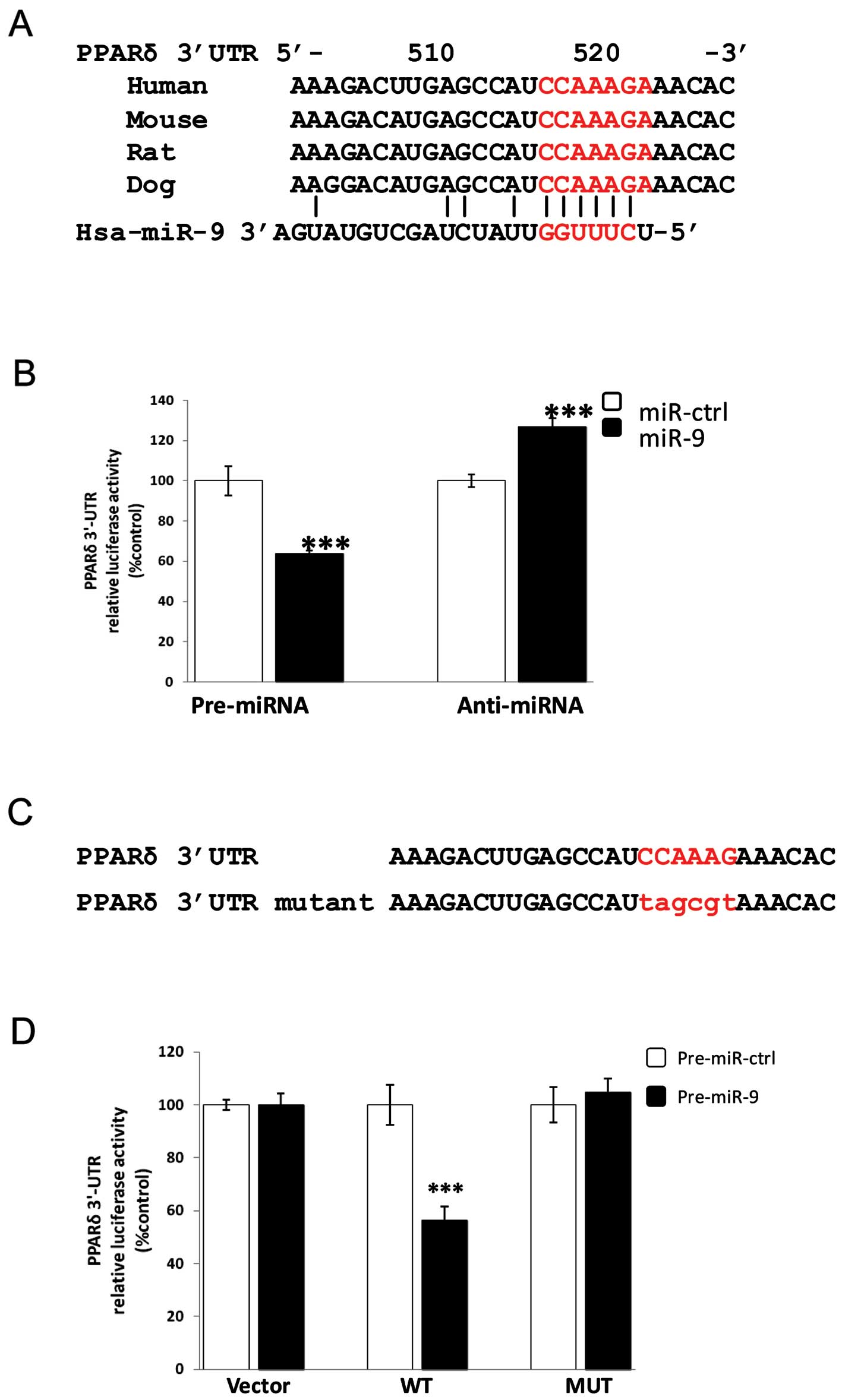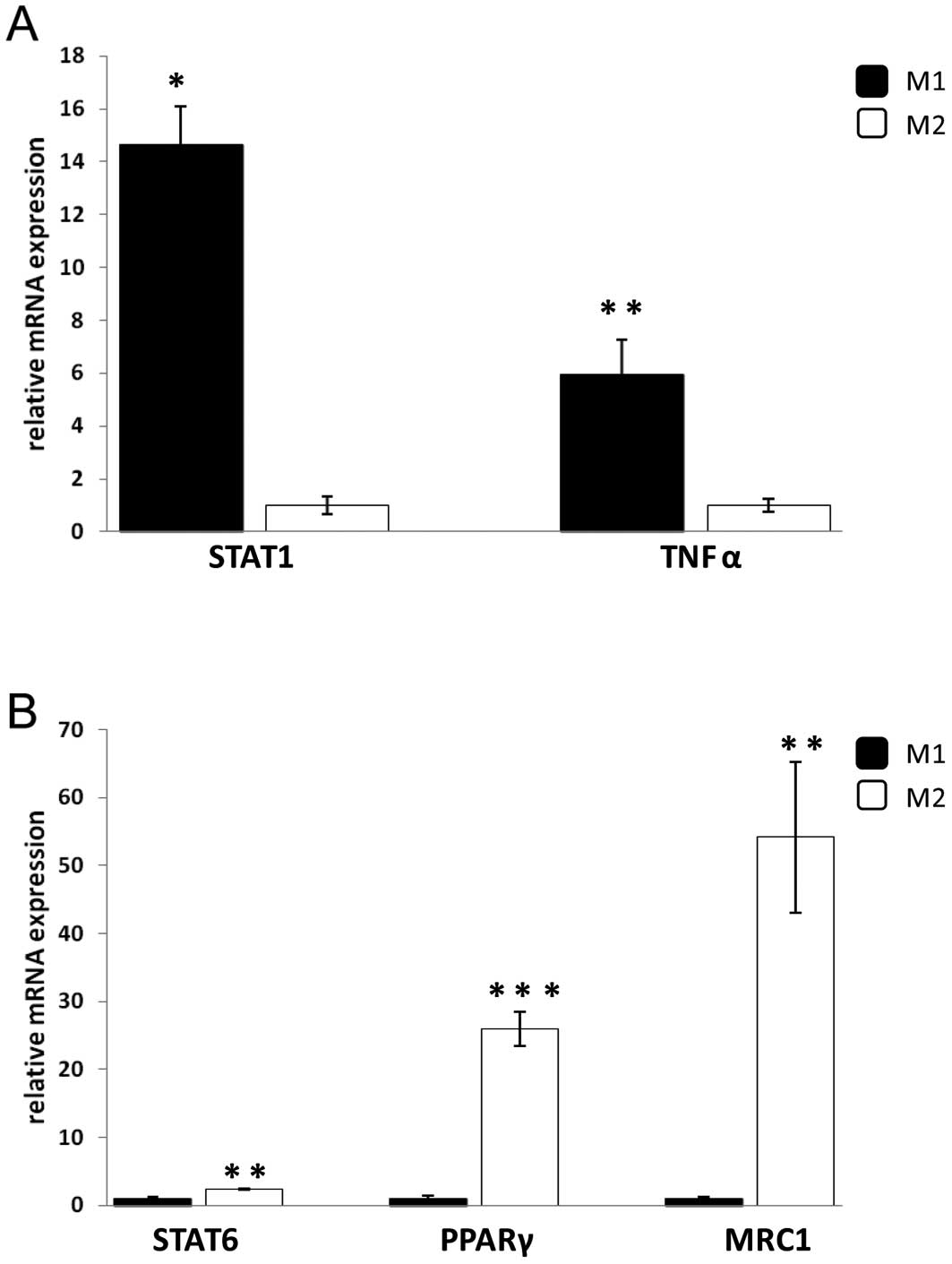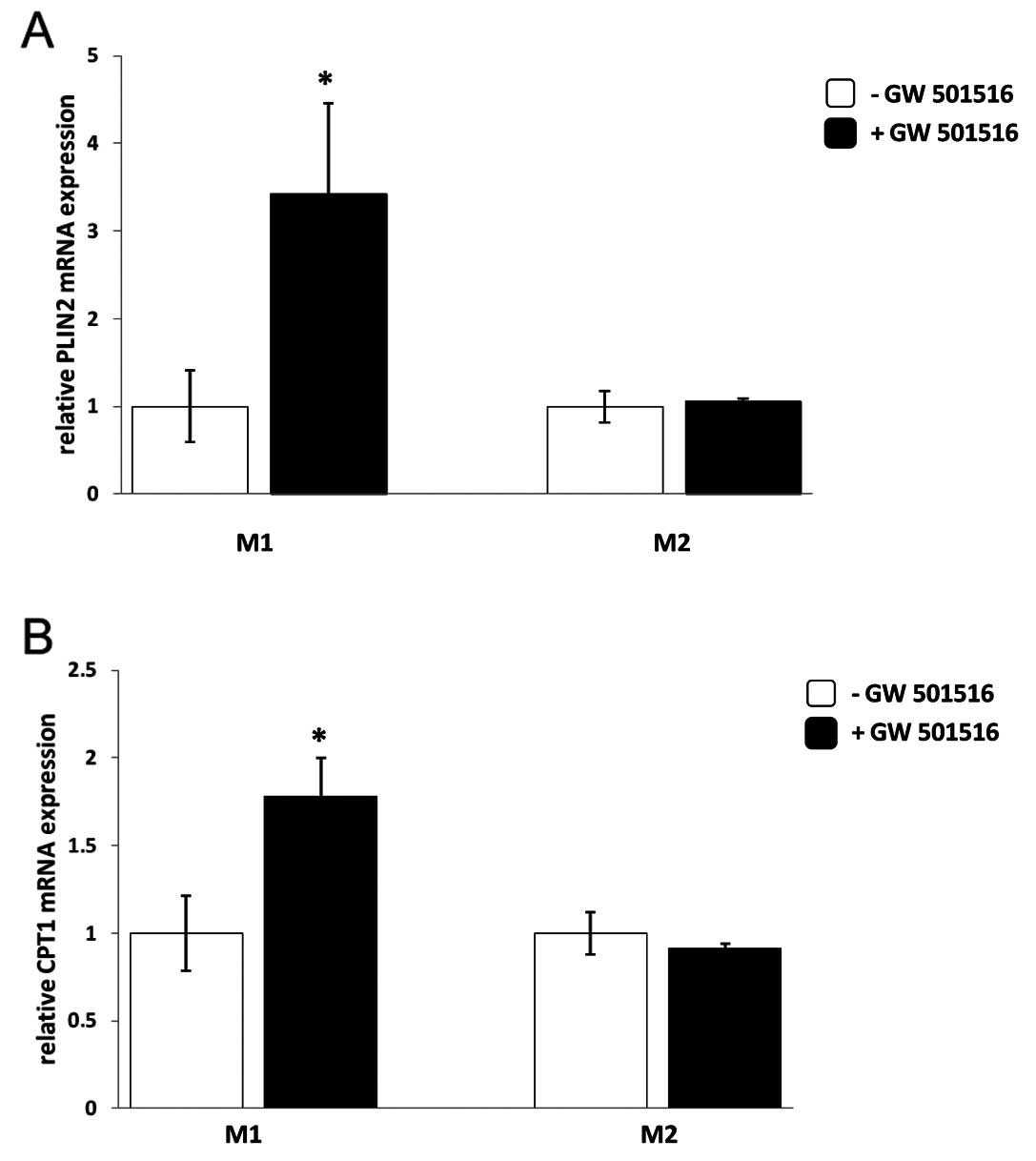|
1
|
Ehrenborg E and Krook A: Regulation of
skeletal muscle physiology and metabolism by peroxisome
proliferator-activated receptor δ. Pharmacol Rev. 61:373–393.
2009.
|
|
2
|
Yessoufou A and Wahli W: Multifaceted
roles of peroxisome proliferator-activated receptors (PPARs) at the
cellular and whole organism levels. Swiss Med Wkly.
140:w130712010.PubMed/NCBI
|
|
3
|
Barish GD, Narkar VA and Evans RM: PPARδ:
a dagger in the heart of the metabolic syndrome. J Clin Invest.
116:590–597. 2006.
|
|
4
|
Bazzoni F, Rossato M, Fabbri M, et al:
Induction and regulatory function of miR-9 in human monocytes and
neutrophils exposed to proinflammatory signals. Proc Natl Acad Sci
USA. 106:5282–5287. 2009. View Article : Google Scholar : PubMed/NCBI
|
|
5
|
Barroso E, Eyre E, Palomer X and
Vázquez-Carrera M: The peroxisome proliferator-activated receptor
β/δ (PPARβ/δ) agonist GW501516 prevents TNF-α-induced NF-κB
activation in human HaCaT cells by reducing p65 acetylation through
AMPK and SIRT1. Biochem Pharmacol. 81:534–543. 2011.
|
|
6
|
Kang K, Reilly SM, Karabacak V, et al:
Adipocyte-derived Th2 cytokines and myeloid PPARδ regulate
macrophage polarization and insulin sensitivity. Cell Metab.
7:485–495. 2008.PubMed/NCBI
|
|
7
|
Odegaard JI, Ricardo-Gonzalez RR, Red
Eagle A, et al: Alternative M2 activation of kupffer cells by PPARδ
ameliorates obesity-induced insulin resistance. Cell Metab.
7:496–507. 2008.PubMed/NCBI
|
|
8
|
Chinetti-Gbaguidi G, Baron M, Bouhlel MA,
et al: Human atherosclerotic plaque alternative macrophages display
low cholesterol handling but high phagocytosis because of distinct
activities of the PPARgamma and LXRalpha pathways. Circ Res.
108:985–995. 2011. View Article : Google Scholar
|
|
9
|
Bouhlel MA, Brozek J, Derudas B, et al:
Unlike PPARgamma, PPARalpha or PPARdelta activation does not
promote human monocyte differentiation toward alternative
macrophages. Biochem Biophys Res Commun. 386:459–462. 2009.
View Article : Google Scholar
|
|
10
|
Bartel DP: MicroRNAs: genomics,
biogenesis, mechanism, and function. Cell. 116:281–297. 2004.
View Article : Google Scholar : PubMed/NCBI
|
|
11
|
Chekulaeva M and Filipowicz W: Mechanisms
of miRNA-mediated post-transcriptional regulation in animal cells.
Curr Opin Cell Biol. 21:452–460. 2009. View Article : Google Scholar : PubMed/NCBI
|
|
12
|
Dahan O, Gingold H and Pilpel Y:
Regulatory mechanisms and networks couple the different phases of
gene expression. Trends Genet. 27:316–322. 2011. View Article : Google Scholar : PubMed/NCBI
|
|
13
|
Martinez-Nunez RT, Louafi F and
Sanchez-Elsner T: The interleukin 13 (IL-13) pathway in human
macrophages is modulated by microRNA-155 via direct targeting of
interleukin 13 receptor alpha1 (IL13Ralpha1). J Biol Chem.
286:1786–1794. 2011. View Article : Google Scholar : PubMed/NCBI
|
|
14
|
Martinelli R, Nardelli C, Pilone V, et al:
miR-519d overexpression is associated with human obesity. Obesity.
18:2170–2176. 2010. View Article : Google Scholar : PubMed/NCBI
|
|
15
|
Zhou J, Wang K-C, Wu W, et al: MicroRNA-21
targets peroxisome proliferator-activated receptor-alpha in an
autoregulatory loop to modulate flow-induced endothelial
inflammation. Proc Natl Acad Sci USA. 108:10355–10360. 2011.
View Article : Google Scholar : PubMed/NCBI
|
|
16
|
Tong JL, Zhang CP, Nie F, et al: MicroRNA
506 regulates expression of PPAR alpha in
hydroxycamptothecin-resistant human colon cancer cells. FEBS Lett.
585:3560–3568. 2011. View Article : Google Scholar : PubMed/NCBI
|
|
17
|
Karbiener M, Fischer C, Nowitsch S, et al:
microRNA miR-27b impairs human adipocyte differentiation and
targets PPARgamma. Biochem Biophys Res Commun. 390:247–251. 2009.
View Article : Google Scholar : PubMed/NCBI
|
|
18
|
Kim SY, Kim AY, Lee HW, et al: miR-27a is
a negative regulator of adipocyte differentiation via suppressing
PPARgamma expression. Biochem Biophys Res Commun. 392:323–328.
2010. View Article : Google Scholar : PubMed/NCBI
|
|
19
|
Lee EK, Lee MJ, Abdelmohsen K, et al:
miR-130 suppresses adipogenesis by inhibiting peroxisome
proliferator-activated receptor gamma expression. Mol Cell Biol.
31:626–638. 2011. View Article : Google Scholar : PubMed/NCBI
|
|
20
|
Repnik U, Knezevic M and Jeras M: Simple
and cost-effective isolation of monocytes from buffy coats. J
Immunol Methods. 278:283–292. 2003. View Article : Google Scholar : PubMed/NCBI
|
|
21
|
Glinghammar B, Skogsberg J, Hamsten A and
Ehrenborg E: PPARδ activation induces COX-2 gene expression and
cell proliferation in human hepatocellular carcinoma cells. Biochem
Biophys Res Commun. 308:361–368. 2003.
|
|
22
|
Lundell K, Thulin P, Hamsten A and
Ehrenborg E: Alternative splicing of human peroxisome
proliferator-activated receptor delta (PPARdelta):effects on
translation efficiency and trans-activation ability. BMC Mol Biol.
8:702007. View Article : Google Scholar
|
|
23
|
Contreras J and Rao DS: MicroRNAs in
inflammation and immune responses. Leukemia. 26:404–413. 2012.
View Article : Google Scholar : PubMed/NCBI
|
|
24
|
Wagner K-D and Wagner N: Peroxisome
proliferator-activated receptor beta/delta (PPARδ) acts as
regulator of metabolism linked to multiple cellular functions.
Pharmacol Ther. 125:423–435. 2010.
|
|
25
|
Zhang Y, Liao Y, Wang D, et al: Altered
expression levels of miRNAs in serum as sensitive biomarkers for
early diagnosis of traumatic injury. J Cell Biochem. 112:2435–2442.
2011. View Article : Google Scholar : PubMed/NCBI
|
|
26
|
Krichevsky AM, Sonntag K-C, Isacson O and
Kosik KS: Specific microRNAs modulate embryonic stem cell–derived
neurogenesis. Stem Cells. 24:857–864. 2006.
|
|
27
|
Nie K, Gomez M, Landgraf P, et al:
MicroRNA-mediated down-regulation of PRDM1/Blimp-1 in
Hodgkin/Reed-Sternberg cells: a potential pathogenetic lesion in
Hodgkin lymphomas. Am J Pathol. 173:242–252. 2008. View Article : Google Scholar : PubMed/NCBI
|
|
28
|
Ma L, Young J, Prabhala H, et al: miR-9, a
MYC/MYCN-activated microRNA, regulates E-cadherin and cancer
metastasis. Nat Cell Biol. 12:247–256. 2010.PubMed/NCBI
|
|
29
|
Plaisance V, Abderrahmani A, Perret-Menoud
V, Jacquemin P, Lemaigre F and Regazzi R: MicroRNA-9 controls the
expression of granuphilin/Slp4 and the secretory response of
insulin-producing cells. J Biol Chem. 281:26932–26942. 2006.
View Article : Google Scholar : PubMed/NCBI
|
|
30
|
Agami R: microRNAs, RNA binding proteins
and cancer. Eur J Clin Invest. 40:370–374. 2010. View Article : Google Scholar : PubMed/NCBI
|
|
31
|
Tan NS, Michalik L, Noy N, et al: Critical
roles of PPAR beta/delta in keratinocyte response to inflammation.
Genes Dev. 15:3263–3277. 2001. View Article : Google Scholar : PubMed/NCBI
|
|
32
|
Delerive P, De Bosscher K, Besnard S, et
al: Peroxisome proliferator-activated receptor alpha negatively
regulates the vascular inflammatory gene response by negative
cross-talk with transcription factors NF-kappaB and AP-1. J Biol
Chem. 274:32048–32054. 1999. View Article : Google Scholar
|
|
33
|
Guo L-M, Pu Y, Han Z, et al: MicroRNA-9
inhibits ovarian cancer cell growth through regulation of NF-κB1.
FEBS J. 276:5537–5546. 2009.PubMed/NCBI
|
|
34
|
Wan H-Y, Guo L-M, Liu T, Liu M, Li X and
Tang H: Regulation of the transcription factor NF-kappaB1 by
microRNA-9 in human gastric adenocarcinoma. Mol Cancer. 9:162010.
View Article : Google Scholar : PubMed/NCBI
|
|
35
|
Wolfs IM, Donners MM and de Winther MP:
Differentiation factors and cytokines in the atherosclerotic plaque
micro-environment as a trigger for macrophage polarisation. Thromb
Haemost. 106:763–771. 2011. View Article : Google Scholar : PubMed/NCBI
|
|
36
|
Lee CH, Chawla A, Urbiztondo N, et al:
Transcriptional repression of atherogenic inflammation: modulation
by PPARdelta. Science. 302:453–457. 2003. View Article : Google Scholar : PubMed/NCBI
|
|
37
|
Kharroubi I, Lee CH, Hekerman P, et al:
BCL-6: a possible missing link for anti-inflammatory PPAR-δ
signalling in pancreatic beta cells. Diabetologia. 49:2350–2358.
2006.PubMed/NCBI
|
|
38
|
Chen T, Huang Z, Wang L, et al:
MicroRNA-125a-5p partly regulates the inflammatory response, lipid
uptake, and ORP9 expression in oxLDL-stimulated
monocyte/macrophages. Cardiovasc Res. 83:131–139. 2009. View Article : Google Scholar : PubMed/NCBI
|
|
39
|
Peters JM and Gonzalez FJ: Sorting out the
functional role(s) of peroxisome proliferator-activated
receptor-β/δ (PPARβ/δ) in cell proliferation and cancer. Biochim
Biophys Acta. 1796:230–241. 2009.PubMed/NCBI
|
|
40
|
Mukundan L, Odegaard JI, Morel CR, et al:
PPAR-[delta] senses and orchestrates clearance of apoptotic cells
to promote tolerance. Nat Med. 15:1266–1272. 2009.
|
















